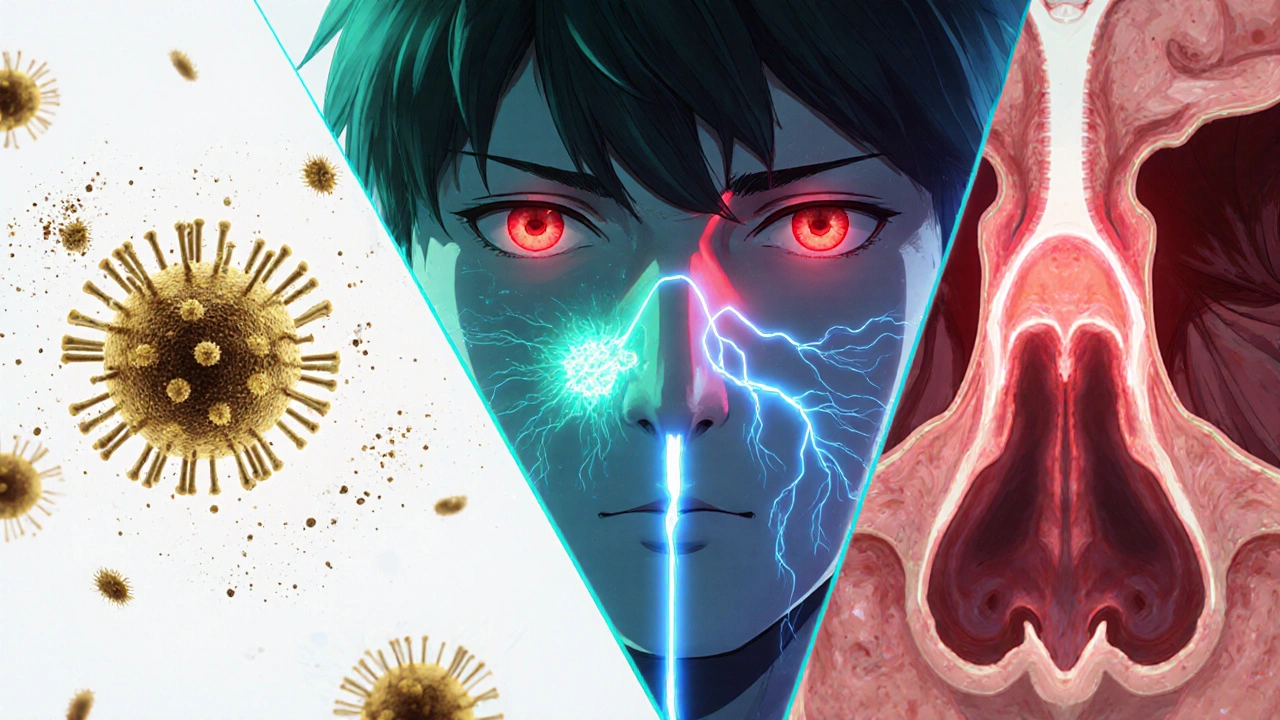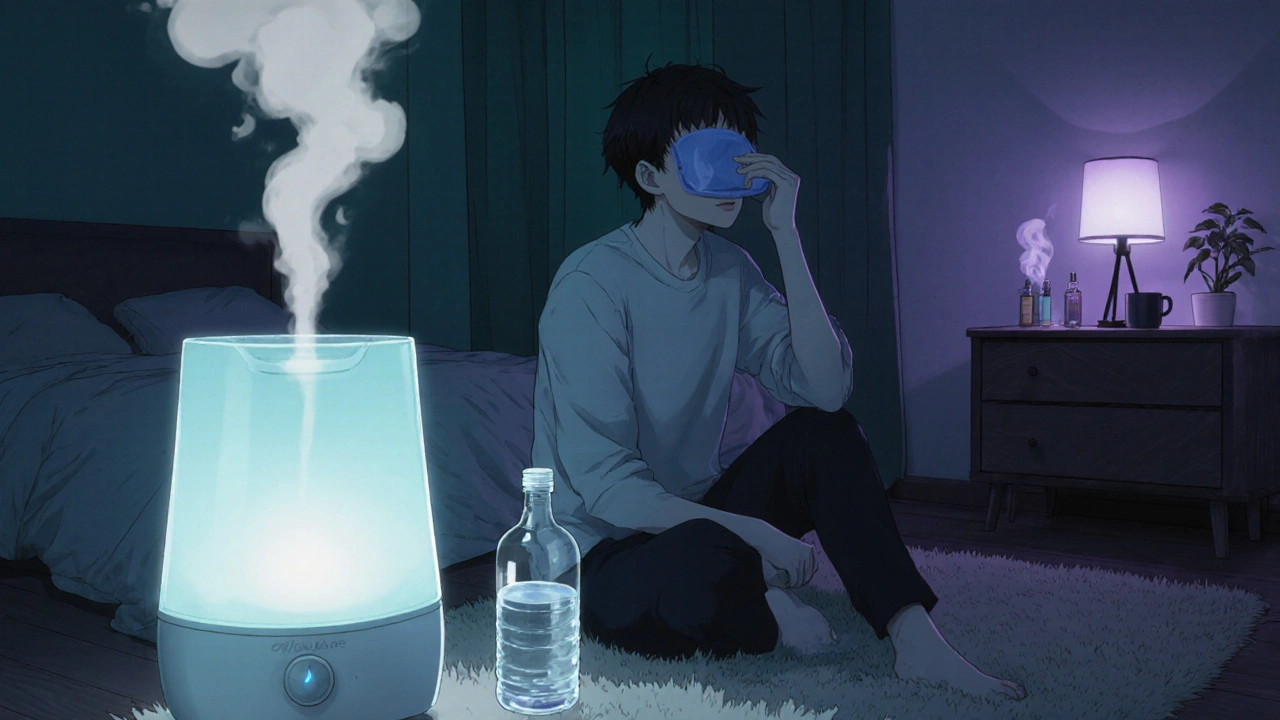Symptom Relief Calculator
Your Symptoms
Likely Triggers
Recommended Relief
Select your symptoms and triggers to see personalized recommendations
Did you know that more than 1 in 5 adults reports chronic nasal congestion or eye irritation that interferes with work, sleep, and even simple tasks like reading a menu? When a blocked-up nose meets red, watery eyes, the combined discomfort can feel like a full‑body problem, not just a seasonal nuisance.
What Exactly Is Nasal Congestion?
Nasal Congestion is a condition where the nasal passages become swollen and filled with mucus, making it hard to breathe through the nostrils. The swelling usually results from inflamed blood vessels lining the nose, triggered by viruses, allergens, or irritants. Common sensations include a feeling of pressure, a need to constantly clear the throat, and reduced sense of smell.
Understanding Red, Watery Eyes
Red Watery Eyes describe the visible redness and excessive tearing that occur when the thin blood vessels on the eye’s surface dilate and the lacrimal glands produce more tears than usual. This response is often an attempt to flush out irritants or allergens, but it can leave the eyes feeling gritty, swollen, and blurry.
How These Symptoms Mess With Your Daily Life
- Sleep quality drops: A blocked nose forces mouth breathing, which dries out the throat and shortens deep‑sleep cycles. Watery eyes can cause nighttime vision blur, prompting frequent awakenings.
- Work performance suffers: Reduced oxygen intake leads to headaches and fatigue, while eye irritation makes screen time painful and lowers concentration.
- Exercise feels harder: Breathing through a congested nose limits oxygen flow, and teary eyes can make wearing goggles or sunglasses uncomfortable.
- Social interactions become awkward: Constant blowing, sniffling, or wiping eyes can be distracting, and the visible redness may be mistaken for illness.
- Driving safety declines: Blurred vision from tears and reduced alertness from poor sleep raise the risk of accidents.
Common Triggers Behind the Pair
Although the nose and eyes seem like separate parts, they share nerve pathways and mucous membranes, so a single trigger often hits both.
- Common Cold - Viral infections such as rhinovirus cause inflammation of the nasal lining and stimulate tear production as the body tries to flush the virus.
- Allergic Rhinitis - Pollen, dust mites, or pet dander trigger an immune response that releases histamine, leading to both nasal swelling and conjunctival redness.
- Sinusitis - When sinus cavities become inflamed, pressure builds up, spilling mucus into the throat and eyes.
- Environmental Irritants - Smoke, strong odors, or dry indoor air can irritate both the nasal passages and ocular surface.

Quick Relief Options for Nasal Congestion
Below is a handy comparison of the most used over‑the‑counter (OTC) remedies. Choose a method that fits your lifestyle and symptom severity.
| Treatment | How It Works | Typical Use | Pros | Cons |
|---|---|---|---|---|
| Saline Nasal Rinse | Physically flushes mucus and allergens | 2‑3 times daily | Non‑medicinal, safe for long‑term | May cause temporary ear pressure |
| Nasal Decongestant Spray (e.g., oxymetazoline) | Constricts blood vessels, reducing swelling | Every 6‑8hours, max 3 days | Quick relief | Rebound congestion if overused |
| Oral Antihistamine (e.g., cetirizine) | Blocks histamine release | Once daily | Helps if allergy‑driven | May cause drowsiness |
| Steam Inhalation | Moisture loosens mucus | 5‑10min as needed | Natural, inexpensive | Risk of burns if not careful |
Quick Fixes for Red, Watery Eyes
Eye irritation often needs a different set of tools. The table below matches common options with their best use cases.
| Product | How It Works | Best For | Pros | Cons |
|---|---|---|---|---|
| Artificial Tears (preservative‑free) | Lubricates the ocular surface | Dry‑eye component | Immediate soothing | Frequent dosing |
| Antihistamine Eye Drops | Blocks histamine in the conjunctiva | Allergy‑related redness | Fast reduction of itching | May cause temporary stinging |
| Cold Compress | Vasoconstricts surface vessels | General irritation | Non‑medicinal, easy | Only short‑term relief |
| Oral Antihistamine (same as nasal) | Systemic histamine blockade | When both nose and eyes are allergic | Convenient, single pill | Drowsiness risk |
Lifestyle Tweaks That Keep Both Nose and Eyes Happy
- Use a humidifier at night to keep nasal passages moist and reduce tear evaporation.
- Keep windows closed during high pollen counts; run an HEPA filter if possible.
- Stay hydrated - water thins mucus and supports tear production.
- Practice good hand hygiene to lower viral spread.
- Take short breaks from screens every 20 minutes to reduce eye strain.

Red Flags: When to See a Healthcare Provider
Most congestion and eye irritation are harmless, but certain signs signal a deeper issue.
- Fever above 101°F lasting more than 48hours.
- Severe facial pain or swelling that doesn’t improve with OTC meds.
- Vision loss, dark spots, or persistent double vision.
- Green or yellow thick mucus accompanied by facial pressure.
- Symptoms lasting longer than 10‑14days without improvement.
If any of these appear, schedule a visit with your primary care physician or an ENT specialist.
Daily Checklist to Keep Symptoms in Check
- Morning: Rinse sinuses with saline, apply artificial tears if eyes feel dry.
- Mid‑day: Take a short walk outdoors (if pollen low) or use a portable air purifier.
- Afternoon: Re‑hydrate, consider a 5‑minute steam inhalation.
- Evening: Run a humidifier, use a cold compress on eyes after screen time.
- Before bed: Perform a final saline rinse, set an alarm for a 30‑minute nasal spray limit.
Frequently Asked Questions
Can a cold cause red eyes, or is that only allergies?
Both. A viral cold inflames the nasal lining and often triggers reflex tearing, while allergies release histamine that makes the eyes red and itchy. The key difference is that allergy‑related redness usually comes with itching, whereas cold‑related redness is more about watery discharge.
Is it safe to use a nasal decongestant spray for a week?
No. Most sprays are meant for short‑term relief (no more than 3 days). Using them longer can cause rebound congestion, where the nose becomes even more blocked once the medication wears off.
Do eye drops interfere with contact lenses?
Most artificial tears are safe with contacts, but antihistamine drops often contain preservatives that can cling to lenses. Remove lenses, apply the drops, wait a few minutes, then put lenses back in.
How long does it usually take for symptoms to clear?
For a typical cold, nasal congestion and watery eyes improve within 7‑10days. Allergic episodes can linger as long as exposure continues, but antihistamines often bring relief in a few hours.
Can lifestyle changes replace medication?
In mild cases, yes. Keeping indoor humidity around 40‑50%, staying well‑hydrated, and using saline rinses can reduce reliance on drugs. However, severe allergies or infections still benefit from targeted medication.



11 Comments
Cindy Thomas October 17, 2025 AT 14:49
Another so‑called “health tip” that nobody actually follows 🙂.
Kate Marr October 23, 2025 AT 09:42
Look, the American market already pumps out the best saline rinses; if you're buying foreign brands you’re just wasting money 🇺🇸👍.
James Falcone October 29, 2025 AT 03:36
Honestly, just grab a cheap over‑the‑counter spray, it does the trick without overcomplicating things.
Frank Diaz November 3, 2025 AT 22:29
The intertwining of nasal passage and ocular surface is a reminder that our bodies are not a collection of isolated modules but a unified symphony; when one instrument falters, the discord permeates the entire performance. This holistic view challenges the reductionist mindset that treats congestion as merely a nuisance. It demands respect for the cascade of physiological feedback loops, each governed by ancient evolutionary pressures. Ignoring these connections is akin to silencing the strings while the brass blares on, leading to a hollow sound that betrays the underlying structure.
Mary Davies November 9, 2025 AT 17:22
Whoa, you just turned a simple runny nose into a tragic opera, and I’m here for the drama! 🎭
Valerie Vanderghote November 15, 2025 AT 12:16
When you scroll through the endless list of over‑the‑counter solutions, it can feel like you’re drowning in a sea of options that all promise miracles but deliver little more than temporary relief. The truth is that many of these products are designed with profit margins in mind rather than genuine therapeutic efficacy. Take saline rinses, for example, they are essentially sterile water with a hint of salt, yet manufacturers slap on premium pricing and fancy packaging to convince shoppers they’re buying something exotic. Meanwhile, nasal decongestant sprays, though fast‑acting, come with a hidden trap of rebound congestion that can turn a simple blockage into a chronic nightmare if you exceed the three‑day limit. What’s more, the artificial tears you slather on your eyes often contain preservatives that can irritate the very tissue you’re trying to soothe, creating a vicious cycle of dependency. I’ve seen countless friends swap one product for another, only to end up with a cluttered medicine cabinet full of half‑used bottles and no real improvement. In my own experience, the most sustainable relief came from simple lifestyle tweaks that cost pennies rather than dollars. Keeping indoor humidity around forty to fifty percent prevents the nasal lining from drying out and reduces tear evaporation, which alone can cut down on both congestion and watery eyes significantly. Hydration is another cornerstone; drinking enough water thins mucus and supports the tear film, making both systems function more smoothly. A short daily steam inhalation session, even over a bowl of hot water with a towel over your head, loosens mucus without any chemicals. If allergies are the culprit, a high‑efficacy HEPA filter paired with keeping windows shut during peak pollen times can dramatically lower your exposure. Don’t underestimate the power of a quick cold compress on tired eyes after a screen marathon; it’s a cheap, drug‑free way to reduce redness and swelling. And finally, give your body the rest it craves-adequate sleep restores immune function, which helps clear up viral infections faster, reducing the duration of both nasal and ocular symptoms. All these strategies might sound like common sense, but they’re often overlooked in the rush to grab the latest spray or drop. By combining a few of these low‑cost habits, you can reclaim control over your breathing and vision without becoming dependent on a pharmacy’s revolving door. So, before you add another bottle to the shelf, ask yourself whether a simple habit change could be the missing piece you’ve been searching for.
Michael Dalrymple November 21, 2025 AT 07:09
Implementing the checklist you’ve outlined-morning saline rinse, midday hydration, evening humidifier-creates a structured routine that not only alleviates symptoms but also reinforces healthy habits, ultimately supporting long‑term respiratory and ocular health.
Emily (Emma) Majerus November 27, 2025 AT 02:02
Try a cheap saline spray before bed; it clears mucus and cuts night‑time stuffiness.
Virginia Dominguez Gonzales December 2, 2025 AT 20:56
Oh wow, that simple spray before sleep really turned my nights from a foggy war zone into a calm sunrise-thanks for the lifeline! 🌅
Carissa Padilha December 8, 2025 AT 15:49
What they don’t tell you is that big pharma is quietly suppressing the real cure for that nasty combo of a blocked nose and watery eyes, pushing cheap band‑aids while they fund research that never sees the light of day.
Richard O'Callaghan December 14, 2025 AT 10:42
yeah sure, like they r actually hidin some miracle cure – it’s all sus, i think we need to look deeper.